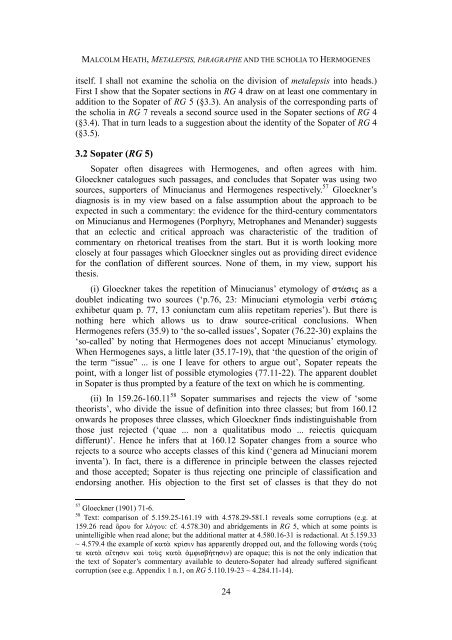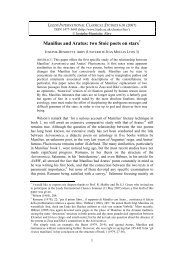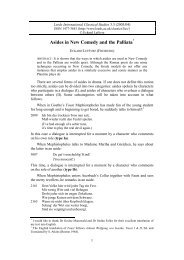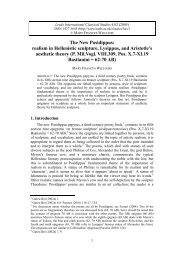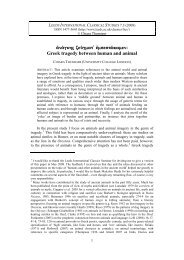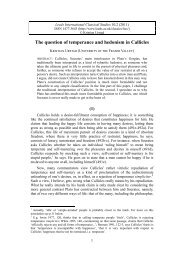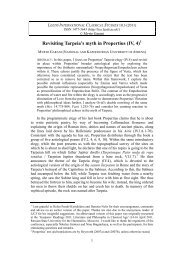Metalepsis, paragraphe and the scholia to Hermogenes - Leeds ...
Metalepsis, paragraphe and the scholia to Hermogenes - Leeds ...
Metalepsis, paragraphe and the scholia to Hermogenes - Leeds ...
Create successful ePaper yourself
Turn your PDF publications into a flip-book with our unique Google optimized e-Paper software.
MALCOLM HEATH, METALEPSIS, PARAGRAPHE AND THE SCHOLIA TO HERMOGENES<br />
itself. I shall not examine <strong>the</strong> <strong>scholia</strong> on <strong>the</strong> division of metalepsis in<strong>to</strong> heads.)<br />
First I show that <strong>the</strong> Sopater sections in RG 4 draw on at least one commentary in<br />
addition <strong>to</strong> <strong>the</strong> Sopater of RG 5 (§3.3). An analysis of <strong>the</strong> corresponding parts of<br />
<strong>the</strong> <strong>scholia</strong> in RG 7 reveals a second source used in <strong>the</strong> Sopater sections of RG 4<br />
(§3.4). That in turn leads <strong>to</strong> a suggestion about <strong>the</strong> identity of <strong>the</strong> Sopater of RG 4<br />
(§3.5).<br />
3.2 Sopater (RG 5)<br />
Sopater often disagrees with <strong>Hermogenes</strong>, <strong>and</strong> often agrees with him.<br />
Gloeckner catalogues such passages, <strong>and</strong> concludes that Sopater was using two<br />
sources, supporters of Minucianus <strong>and</strong> <strong>Hermogenes</strong> respectively. 57 Gloeckner’s<br />
diagnosis is in my view based on a false assumption about <strong>the</strong> approach <strong>to</strong> be<br />
expected in such a commentary: <strong>the</strong> evidence for <strong>the</strong> third-century commenta<strong>to</strong>rs<br />
on Minucianus <strong>and</strong> <strong>Hermogenes</strong> (Porphyry, Metrophanes <strong>and</strong> Men<strong>and</strong>er) suggests<br />
that an eclectic <strong>and</strong> critical approach was characteristic of <strong>the</strong> tradition of<br />
commentary on rhe<strong>to</strong>rical treatises from <strong>the</strong> start. But it is worth looking more<br />
closely at four passages which Gloeckner singles out as providing direct evidence<br />
for <strong>the</strong> conflation of different sources. None of <strong>the</strong>m, in my view, support his<br />
<strong>the</strong>sis.<br />
(i) Gloeckner takes <strong>the</strong> repetition of Minucianus’ etymology of st£sij as a<br />
doublet indicating two sources (‘p.76, 23: Minuciani etymologia verbi st£sij<br />
exhibetur quam p. 77, 13 coniunctam cum aliis repetitam reperies’). But <strong>the</strong>re is<br />
nothing here which allows us <strong>to</strong> draw source-critical conclusions. When<br />
<strong>Hermogenes</strong> refers (35.9) <strong>to</strong> ‘<strong>the</strong> so-called issues’, Sopater (76.22-30) explains <strong>the</strong><br />
‘so-called’ by noting that <strong>Hermogenes</strong> does not accept Minucianus’ etymology.<br />
When <strong>Hermogenes</strong> says, a little later (35.17-19), that ‘<strong>the</strong> question of <strong>the</strong> origin of<br />
<strong>the</strong> term “issue” ... is one I leave for o<strong>the</strong>rs <strong>to</strong> argue out’, Sopater repeats <strong>the</strong><br />
point, with a longer list of possible etymologies (77.11-22). The apparent doublet<br />
in Sopater is thus prompted by a feature of <strong>the</strong> text on which he is commenting.<br />
(ii) In 159.26-160.11 58 Sopater summarises <strong>and</strong> rejects <strong>the</strong> view of ‘some<br />
<strong>the</strong>orists’, who divide <strong>the</strong> issue of definition in<strong>to</strong> three classes; but from 160.12<br />
onwards he proposes three classes, which Gloeckner finds indistinguishable from<br />
those just rejected (‘quae ... non a qualitatibus modo ... reiectis quicquam<br />
differunt)’. Hence he infers that at 160.12 Sopater changes from a source who<br />
rejects <strong>to</strong> a source who accepts classes of this kind (‘genera ad Minuciani morem<br />
inventa’). In fact, <strong>the</strong>re is a difference in principle between <strong>the</strong> classes rejected<br />
<strong>and</strong> those accepted; Sopater is thus rejecting one principle of classification <strong>and</strong><br />
endorsing ano<strong>the</strong>r. His objection <strong>to</strong> <strong>the</strong> first set of classes is that <strong>the</strong>y do not<br />
57 Gloeckner (1901) 71-6.<br />
58 Text: comparison of 5.159.25-161.19 with 4.578.29-581.1 reveals some corruptions (e.g. at<br />
159.26 read Órou for lÒgou: cf. 4.578.30) <strong>and</strong> abridgements in RG 5, which at some points is<br />
unintelligible when read alone; but <strong>the</strong> additional matter at 4.580.16-31 is redactional. At 5.159.33<br />
~ 4.579.4 <strong>the</strong> example of kat¦ kr…sin has apparently dropped out, <strong>and</strong> <strong>the</strong> following words (<strong>to</strong>Új<br />
te kat¦ a‡thsin kaˆ <strong>to</strong>Ýj kat¦ ¢mfisb»thsin) are opaque; this is not <strong>the</strong> only indication that<br />
<strong>the</strong> text of Sopater’s commentary available <strong>to</strong> deutero-Sopater had already suffered significant<br />
corruption (see e.g. Appendix 1 n.1, on RG 5.110.19-23 ~ 4.284.11-14).<br />
24


